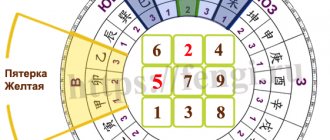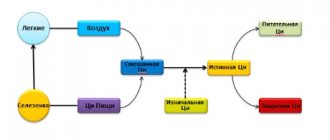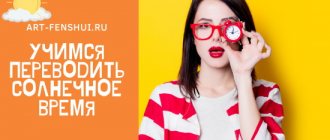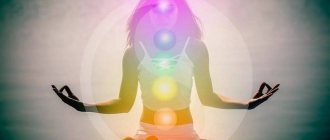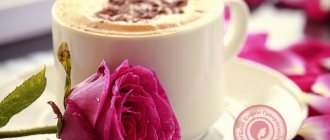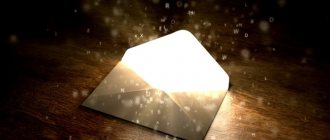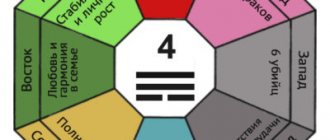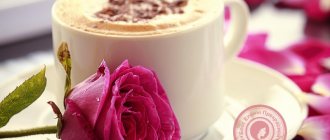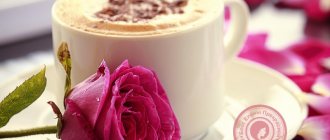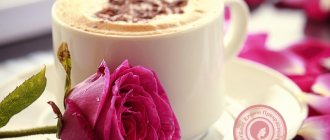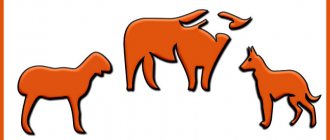Every person sooner or later thinks about the nature of his existence. What drives his emotions, why do people with pure thoughts look different than people overwhelmed by negative thoughts?
Writers, thinkers, scientists, and philosophers have been looking for answers to these questions for thousands of years. In Chinese culture, there is a philosophical category called “qi”, “chi” or, in Japanese, “ki”, which is the beginning and primary source of everything on Earth, that is, vital energy.
How to recognize the Qi energy in yourself?
Have you ever observed a couple in which the spouses finish each other’s sentences or, without saying a word, start a sentence at the same time? Have you ever had a feeling of déjà vu, as if something has already happened to you and you know exactly what will happen next? "Mystic!" - you say. “Nature,” the masters of ancient practices will answer.
Hieroglyph Qi
Synchronization of the energies that nourish people, or correct functioning, which is directed in the right direction, gives a seemingly surprising result for us. But for the Chinese philosophers our surprise would be funny, as if the sun did not believe in the existence of its rays or a tree - in that which has branches.
It is no coincidence that the saying arose in Tibet: “He who has Qi blooms, but he who loses it dies . But if each of us has this powerful energy, how can we use it, how can we return it to its original channel and become that same source of happiness about which so many books and philosophical treatises have been written? The answer is simple: look inside yourself.
Meaning of the character Qi
Tattoo in the form of the hieroglyph Qi
In order to understand the meaning of the ancient hieroglyph Qi, you need to divide it into 2 parts. The upper part of the hieroglyph represents 3 types of energy: the energy of heaven, earth and nature. Thus, dividing it into 3 main components, it is important to understand that this is not a separate type of energy, but at the same time everything and nothing.
The lower part is depicted as a diagram of the directions of energy action on humans, animals and nature. Using the second part of the hieroglyph, we get a map of the “dragon lines” described above.
The hieroglyph Qi is often used in everyday life, when decorating furniture, in jewelry, paintings, and home interior items. It is believed that the presence of this hieroglyph contributes to well-being and comfort in the home. You can also often notice tattoos in the form of this hieroglyph.
Exercises to accumulate energy
So, you have decided to awaken your Qi energy. But first, masters of spiritual practices advise: do not identify this concept with some kind of superpower that will overnight bring all sorts of benefits into your life. Qi, like any category in Asian philosophy, is the fruit of long and persistent study, careful concentration and daily work on oneself.
Humbly starting the path, the warrior is ready to go to the end and only having reached the top can he return to his roots:
- stand straight, feet should be at least 45 cm apart;
- the next step is to bend your knees slightly so that they spring. The back remains straight;
- spread your arms to the sides, palms raised, fingers pointing straight up;
- close your eyes and concentrate on your inner sensations. You need to stay in this position for 5-10 minutes.
After the Qi energy has awakened, a phase begins during which it is necessary to pacify or curb the powerful flow of force that chaotically exists in a person. How to do it? To begin with, the masters instruct on general cleansing: getting rid of negative thoughts, feelings and the environment so that the body and soul are at peace.
You yourself will feel how something inside you gradually awakens and you begin to pay attention to pleasant little things, notice the smiles on the faces of passers-by and give them in return. The time is coming to get to know your Qi directly.
What is needed to develop Qi?
In the immediate practical part of the work to develop your energy, you need to learn that the secret of success of martial arts masters of China and Japan lies in the combination of several factors: Qi opens to pure thoughts, pure intentions, a pure soul and body.
This means that a person must reveal his whole self towards his real “I”. Each point of the body is a conductor of cosmic energy that permeates the Universe.
The cycle of practices will include both meditative and physical exercises:
Let's adjust our breathing. Take a comfortable position, your body should be relaxed. Pay very close attention to the frequency of your inhalations and exhalations. You should focus on this process and not be distracted by extraneous thoughts. To make it easier to perform this seemingly simple exercise, close your eyes, as unnecessary thoughts can disrupt the correct breathing rate. The exercise should be performed for three to ten minutes. Breathe deeply and slowly throughout your chest and belly;- Qi circulation in the body is no longer chaotic, you can use your hands. To send energy flows through the body to space, imagine that Qi is a warm clot of energy in the shape of a ball. We bring our right hand to our face so that the palm is turned with the back side to the ground, and we hold the left hand in the solar plexus area, respectively, with the back side up. Gradually we bring them closer to each other, feeling a warm ball between them, we begin to rotate, without ceasing to concentrate on breathing.
It is no coincidence that the practice of Qigong has become very popular all over the world, since, having mastered its techniques (of which there are a great many), a person is able to get rid of a lot of ailments, including such common ones as chronic fatigue, sleep disorders, problems with the nervous system, vegetative -vascular dystonia, metabolic imbalance, weak immunity and much more.
Systems developed over centuries are used in folk medicine, martial arts, and physical exercises.
The body remembers elementary movements, repeated day after day, for a short time, and you yourself will not notice how every morning you will want to start with such an unusual exercise. Only instead of lifting heavy dumbbells in the gym or exhausting marathon running, you will begin to dialogue with your inner self, directing the energy of creation through your channels into space and accepting the healing gifts of the earth.
In addition to the metaphysical component, the practical results are also undeniable. One has only to remember that Qigong is one of the favorite activities among elderly residents of Japan, China, Korea, and some Asian countries. And thanks not only to good genes and living conditions, but largely to these ancient practices, grandparents in the Middle Kingdom and the Land of the Rising Sun are reputed to be long-lived and have a clear mind.
Definition of Qi
Chinese philosophers and physicians define Qi energy as one of their fundamental concepts. Every person, material objects, corners of space are permeated with Qi energy. Any action, love, strength cannot do without the participation of vital energy. Balance and constant flow of Qi are associated with health and human activity. Both physical health and emotional and psychological state depend on its balance. Qi energy is classified into the following types:
- innate Qi, which determines genetics – passed on by parents at conception;
- Qi energy from the air – through breathing the body is filled with life energy from the air;
- Qi from food - when food enters the stomach, Qi energy is released, which is converted through the spleen and fills all organs;
- Protective Qi energy – immunity against harmful influences.
Innate Qi is stored by the kidneys, but the resource is subject to depletion. Factors such as work pressure, stress, and the use of any stimulant drugs or drinks have a negative impact on Qi. And following the correct daily regimen and drinking enough clean water every day contribute to its preservation. The air condition also affects. Dirty air worsens the human body's resistance to diseases and harmful manifestations. Healthy food enriches a person with vital Qi energy. Therefore, it is so important to eat natural foods, especially fresh ones, excluding dyes, preservatives and artificial additives. Human energy, protective Qi, surrounding our body helps regulate the body's protective forces.
Read our article “A rosary made of 108 beads: symbolism and practical application.”
Exercise "Big Tree"
Step-by-step implementation of the “Big Tree” exercise:
- open your channels. To do this, fold the index and middle fingers of your right hand like a scraper, and slide the phalanges along the sides of the fingers of your left hand. At the same time, imagine that you are clearing karmic debris from your hand-channels. Repeat the exercise several times, changing hands;
- stand in the same position as in the first example when you awakened the Chi energy. But now it is necessary that the tongue touches the upper palate, the eyes are also closed;
- now imagine that you become a huge powerful tree: your legs lengthen and penetrate deep into the ground, becoming roots, your arms turn into branches and stretch high towards the sun. In this exercise, it is important to concentrate on mental images, vividly imagining a picture of your transformation. Some practices even advise drawing these scenes on paper, because drawing is also a kind of meditation;
- hands rise to the level of the lower back, elbows are placed perpendicular to the body, imagine that you are holding something fragile in the armpits, for fear of crushing the object;
- your hands fold around an invisible energy ball, which gradually begins to nourish you with its warmth; rotate it with slow movements.
Speaking of painting, the Chinese Guohua style perfectly illustrates the concept that Qi energy is found not only in living beings, but even in works of art.
Exercise "Big Tree"
According to the author of the book “Chinese Brush Painting” Viv Foster, a good painting has spirit, and Qi energy is transmitted even through the slightest strokes, through highlights, colors, light and shade, and creates a unique atmosphere, forms the aura of the place where it is located.
Help the baby
The energy of creation of Yuan-Chi (Qi) “Qi Energy”Purely materialistically thinking people need to come to terms with the fact that in European philosophy and science there is no adequate concept for this, and this type of “energy” is not considered. As we mentioned above, qi is not exactly what we mean by “physical energy.” In ancient China, this energy was described as an omnipresent ether, an energy that permeates everything, activity, a functional principle, including life force. In ancient Indian philosophy and medicine, this concept corresponds to prana
- the original and fundamental universal energy, life-giving breath.
.
Qi
is the cause and beginning of all movement and change. In the East it is believed that this is a more subtle substance than that which can be recorded by instruments or ordinary senses.
In Chinese the character qi
denotes several concepts: air, vitality, spirit, mood, mental strength, vital energy, beginning, functional activity of the body.
However, we will also use the term “energy”
as it is closest to the concept of qi and is fairly well established in the European literature on Chinese medicine.
.
Qi
is a necessary component of the human body, the beginning and driving force of its life.
Qi
is divided into external, natural, which enters the human body through breathing, and internal, circulating inside a person.
When breathing, external qi enters the human body, partially transforms into internal qi, and when exhaling, it comes out and is again converted into external qi. This is how the constant circulation of qi energy occurs.
of qi
depends on the state of a person’s respiratory system and this largely determines the general condition of the body.
.
In the human body, internal
qi
circulates through constant channels -
meridians
, which are a traditional concept in Eastern medicine that does not have an anatomical representation ("The Teaching of Meridians -
Jing Lo").
energy ,
called intrauterine, it is formed at the initial stage of development of the embryo, programming the heredity and reserve of vitality of the future person.
After the birth of a child, his qi energy is enriched with the so-called nutritious (postpartum) qi, obtained as a result of breathing and nutrition - Shui Gu Zhi Qi.
The relationship between the two types
of qi
is as follows: the intrauterine one is the driving force of life, and the postnatal one is the material that ensures the maintenance of life.
.
Let's consider the types and localization of qi
as energy and vital force, depending on the place of its origin and action.
.
- Hereditary (primary, or true) energy - yuan qi
(in the treatise "Nei jing" it is called
tingh,
in other literature -
qi
of ancestors) - "
energy" received by a person at his conception
, at the very beginning of the formation of the fetus, before birth.
It determines human development in a certain direction. This type of energy is stored in the kidneys.
.
- Spiritual qi - ting qi
- is formed during the process of conception, but immediately after birth it is distributed among five main organs - liver, heart, spleen, lungs and kidneys, where it develops and is replenished due to the body receiving nutritional and respiratory energy (air, food).
.
- Respiratory energy - tsong qi
- is extracted by the body from natural (external) qi from the inhaled air.
.
- Nutrient energy - yin qi
- is formed before birth in the womb, and begins to function after birth, receiving air and nutrients from food.
.
- Protective energy - wei qi
- is part of
the yang
energy of
qi,
which forms the body's defenses.
.
- Disturbing energy
-
hong
qi - is a degenerated internal energy that has become pathogenic and causes various functional disorders.
.
Hereditary qi.
This energy, as mentioned above, is formed before the birth of a child and is transmitted to him by the parents at the moment of conception;
this is a hereditary energy potential, which is also called the energy of ancestors.
It originates in the kidneys, which contain the roots of
yin
and yang, and penetrates the heart or lungs, through which it enters the main meridian system and circulates throughout the body, returning to the kidneys.
Through constant channels, ancestral qi
circulates along with nutritional and protective
qi.
It accumulates in the kidneys, and its replenishment depends on the systematic supply of nutritious qi.
The book “Ling Shu” says: “True qi exists from birth.
It mixes with nutritious qi and nourishes the body.”
Hereditary qi circulates outside the permanent meridians along with protective
qi
through wonderful channels, through the subcutaneous connective tissue and epidermis, internal tissues and intraosseous cavities.
Hereditary qi regulates the overall energy of the human body. Flowing along the posterior-median meridian (du-mai),
it regulates yang-qi, flowing along the anterior-median
(ren-mai) - yin-qi.
Following other pathways, ancestral qi regulates blood circulation, genitourinary function and mobility.
.
Spread of Ancestral Qi
throughout the body occurs, in particular, through the three heater meridian and is regulated by it. Thanks to its action, the functioning of internal organs occurs; it also supports human growth. The more of this energy in a person’s body, the stronger his internal organs, the less susceptible he is to diseases. When a damaging factor affects the body, it is initially counteracted by protective energy circulating over the surface of the body. Therefore, at the first stage the disease is superficial.
.
If the protective energy is insufficient and the pathogenic principle penetrates deep into the body, then the hereditary qi begins to counteract it. If the hereditary qi
is weak from birth or has become smaller as a result of a long or strong pathological influence, then the internal organs weaken and are no longer able to withstand harmful factors. This is how diseases arise. If the lesion reaches the posteromedial canal, then the symptoms of the disease will be acute, with signs of mental agitation, incoherence of speech, pain along this meridian, muscle spasms, headaches, and increased blood pressure. If, on the contrary, the damage penetrates into the anteromedian canal, then symptoms of asthenia, a drop in blood pressure, and atony along this meridian are detected.
.
.
Excess hereditary energy accumulates in the kidneys in order to leave the kidneys with the onset of puberty and be directed to maintain the functions of the corresponding organs. A person’s sexual function and the ability to have children depend on the fullness of hereditary energy. Thus, in women, the maximum flowering of hereditary energy is observed at 28 years old, and its emptiness - at 49 years old; in men, the maximum is observed at 32 years old, and the emptiness of energy is at 64 years old. These numbers may vary depending on a person's ability to conserve energy. It is known, for example, that many centenarians in the East do not lose their ability to bear children even at a later age. Only a certain way of life, based on the harmony of spirit, body and surrounding nature, helps maintain a sufficient amount of hereditary energy.
Thanks to the kidneys, hereditary energy spreads throughout the body. When the kidneys are damaged, both the energy itself and its circulation are disrupted, which is why in the East the kidneys are called the “root of life.”
The main reasons that deplete hereditary energy are poor nutrition, and in particular, abuse of alcohol, mostly strong (over 18°).
There is a violation of the quality of nutritional energy, which becomes unable to reinforce the hereditary energy. Various kinds of rash actions that destroy intellectual energy, which actively interacts with hereditary qi, also contribute to its depletion.
In the treatises “Huang Di Nei Jing” it is said: “To satisfy the heart means to wound the brain. The heart corresponds to joy: too much joy afflicts the heart.” And finally, sexual intercourse while intoxicated, depleting hereditary energy, leads to rapid aging. Therefore, preserving this energy is the key to longevity and health. From the above it follows that morality of life and abstinence directly have a beneficial effect on objective physiological processes in the human body.
.
.
Spiritual {ting) qi
after arising during the process of fertilization, it is distributed among the five organs and becomes their functions, that is, the beginning of their action.
It is maintained in its continuity of nutritional qi
at the organ level, which is why the Nei Jing says: “Spiritual energy is generated by the five organs.”
Ting Qi
is stored in five organs and therefore has different names depending on location:
- in the heart - dhan (spiritual);
- in the lungs - fach (vital);
- in the liver - hon (spiritual and vital);
- in the spleen - y (thought);
- in the kidneys - chi (will).
But all this is one energy that makes up a single whole. Spiritual Qi
through the heart it reproduces fire -
yang,
the will
of chi
produces water - yin - through the kidneys.
The opposition of fire and water, the interaction of yang
and
yin
maintains balance in the body.
Losing it leads to mental illness. Wu (thought) is the energy of distribution of all other qi. Chi
(will) produces (nourishes) the remaining energies.
Breathing qi.
This energy is produced in the lungs from the natural qi of the air and the nutritious qi produced in the stomach and spleen - pancreas.
Tsong Qi
accumulates in the chest.
Through its power, breathing and the flow of air into the lungs, the work of the heart and blood vessels occur, the depth of breathing and the fullness of the voice, the function of such an important part of the blood circulation as the capillary system and the activity of the whole organism depend on it. Cong Qi
regulates temperature and determines the activity of the limbs.
The book Ling Shu says: “Tsong qi
(breathing qi) accumulates in the chest and exits through the throat.
It enters the blood, into the blood vessels and, in addition, provides breathing.” the concentration of qi
does not descend the blood is retained in the veins and blocked.”
Nutritional energy.
Depending on the taste of the product
qi
obtained during its processing is distributed among five main organs: liver (sour), heart (bitter), spleen (sweet), lungs (spicy), kidneys (salty). Next, the nutritional energy follows through the blood vessels and circulates through them along with the blood, promoting its constant renewal. Circulating with the blood, nutritious qi nourishes all parts and cells of the body.
The functional state of the respiratory and digestive systems largely influences nutritional energy, since nutritional qi moves from the stomach to the lungs. Sources of weakening of this vital force are poor diet, tobacco smoking and excessive alcohol consumption. Nutritional energy maintains the full state of hereditary energy (being its integral part), spiritual and protective, which together determines the state of the basic qi energy
in organism.
Protective energy.
Localized in the superficial layers of the body, circulating through the skin and muscles, this
Wei Qi
prevents the introduction of pathological, disturbing energy into the body through its openings (mouth, nose, etc.).
The protective functional principle of qi
is distributed mainly throughout the body, where it regulates the activity of skin and hair, heats internal dense and hollow organs, performs an important function in opening and closing skin pores, and also protects the surface of the body from the effects of pathogenic external factors.
When unfavorable factors penetrate into the body, it limits their depth. In the book “Ling Shu” we read: “Dei-tsz (protective qi)
is something that warms the muscles, fills the skin, supplies the pores with oil and makes them strong, controlling their opening and closing.”
This is the most important substance in the human body, which is formed in the kidneys and must be constantly replenished with the nourishing substance Shui-Gu Chin
from the spleen and stomach.
Disturbing energy.
With a depleted psycho-emotional or physical state, energy voids are formed in the body precisely in those parts of it where this weakening is most pronounced, where there is a lack of
qi.
As a result
, hish qi is born,
a pathogenic energy that causes various functional disorders.
This energy in the treatise “Nei Jing” is called neither ta
—
it means emptiness in a state of weakness,
ta—
disturbing.
The deeper it penetrates into the body, the more dangerous the damage. The barrier to disturbing energy at the first stage is the protective energy of a person’s wei qi
, and in case of a lack of the latter and deeper penetration
of xi qi, it is
the hereditary energy.
Organ Qi.
All human internal organs also have their own
qi,
that is, their own functional principle, on which the work of the organ depends.
There is qi
of the liver, heart, spleen, lungs and kidneys, etc. These qi of different organs are in constant exchange and communication with other
qi
and constitute the general functional principle of the body as a whole.
Gained Energy
- these are cosmic
(shing qi),
spiritual
(ting
qi) and nutritional energies
(yin qi),
and
mature ones
are hereditary
(yuan qi)
and vital
(thi qi)
energies.
Rice. 3.
The location of the five
tan-tians
with their approximate points:
a (front view):
upper
tan-tian
(point 1 -
yin-tang,
point 2 -
shang-gen)
- cosmic energy;
front tan-tian
(point 3 -
tan-zhong) -
spiritual energy; middle
tan-tian
(point 4 -
qi-hai) -
nutritional energy;
b (rear view):
lower
tan-tian
(point 5 -
hui-yin)
- hereditary energy; rear
tan-tian
(point 6 -
ming-men)
- vital energy
The general functional principle of the body is qi energy,
in addition to circulation along the meridians and vessels, it has certain localization sites in the human body, which are called
tan tien.
There are five such localizations (Fig. 3):
the upper tan-tian,
in which cosmic energy accumulates, controlling and managing all other types of energies in the body;
the front tan-tian,
which accumulates spiritual energy formed during the process of conception;
in the average tan-tian,
nutritional energy is localized, which begins to function after birth;
in the lower tan-tian
the hereditary energy is localized, which transmits the genetic characteristics of a person;
in the posterior tan tien
the vital energy received by a person before birth is localized (diagram 1).
.
So, in a complete organism there are close connections between all its parts. Food and air coming from the environment are converted into nutritional and protective factors in the human body; the nutritional factor circulates in the vessels, and the protective factor circulates in the body and muscles. Under the influence of life force qi
the activity of the whole organism occurs.
The idea of changes and transformations of qi
will be discussed below in the doctrine of organs, and its movements will be developed in the doctrine of meridians.
.
.
The first book of the treatise “Nei Jing” sets out the principles of maintaining health and longevity.
.
The first place is given to the preservation and maintenance of hereditary qi,
vital qi, psychic qi and blood -
hiyet.
At the same time, the main thing is to follow the
yin-yang law,
moderation in nutrition, movement and work.
.
The causes of premature (before the age of 100) death were indicated:
the habit of drinking wine instead of water, lying, and having sexual intercourse while intoxicated.
All this depletes the ancestral and vital qi.
Wine affects the spleen, its energy is disrupted, which leads to damage to digestion.
The latter reduces the nutritional
qi, which cannot adequately support the vital center. Lies affect the intellectual (mental) qi (stored in the heart), sexual intercourse while intoxicated weakens the hereditary qi.
Attachments:
Classic mistakes
Do not make these mistakes under any circumstances, and then harmony will settle in your home:
- do not keep broken things at home;
- flights of stairs must be through so that Qi energy can circulate freely in the space between floors;
- do not leave the trash can by the door;
- Don't hoard old junk. Together with it, you accumulate old memories, negative energy, grievances, etc.;
- the floor in the house must be level. After all, Qi energy moves not only vertically, but also horizontally;
- mirrors placed in the bedroom or opposite the front door also impede the flow of positive energy. Chinese masters who have mastered the art of Feng Shui claim that mirrors, as sacred objects, can also absorb your vitality. Therefore, you should not sleep in close proximity to them;
- In Feng Shui, faulty plumbing is associated with good luck leaving the house: it seems to flow out like water. Therefore, try to promptly repair all household items that require it.
Effective Qi Management
Many people are concerned about the question of how to manage Qi energy, how to effectively manage such energy. There are basic rules by following which you can manage Qi energy:
- can be accumulated and regulated by appropriate exercises;
- people fixated on the speed of obtaining results are not able to achieve harmonious development;
- The principle of grounding (massages, salt baths) should be used by those who feel trembling in the limbs.
In the body, Qi moves along a network of meridians. They are determined only by the corresponding devices. Chinese medicine suggests the subcutaneous location of 12 meridians. The flow of Qi follows a certain path. There are several ways to manage Qi as vital energy:
- meditation - where the mind can move, develop, control energy, like any controlled process;
- breathing practices - thanks to proper diaphragmatic breathing of Qi, vital energy will circulate effectively;
- bodily techniques and procedures - use special exercises and points to regulate the circulation of Qi.
What is Sha?
As with every positive action, so that the balance of natural forces is maintained, there is also a negative side, that is, counteraction. This category in the art of Feng Shui can be called Sha. If Qi is the gentle and light rustle of the wind, like the wings of a butterfly, then Sha is a cruel whirlwind that causes disasters.
There may be objects in or near your home that contribute to the development of this negative flow.
Sha-invoking objects:
- power lines;
- sharp corners of buildings, single protruding corners;
- a cemetery near the house;
- lonely rotten tree;
- saber shaped road.
This is not a complete list, and objects may change depending on the circumstances around you. The main thing is that objects located in the yard or inside the house have a beneficial effect on your well-being and on the state of your household, bringing satisfaction in a metaphysical sense.
How to restore Qi energy and eliminate the influence of Sha energy
If your home is affected by negative sha energy, do not despair. As we said above, Feng Shui methods can correct any situation, and there are many ways to do this. The principle of action is to redirect negative energy and take it away from the house.
- The best way to eliminate the influence of sha energy is to erect a barrier that protects the home and creates an island of calm in front of the front door. These can be either low hedges or fences.
- You can raise the threshold a few centimeters. Thus, you will have to overcome a symbolic barrier that will prevent negative energy from entering the house.
- If there is a direct road leading directly to your home, you can remedy the situation by using decorative overhangs or pockets on either side of the road. The ledges can either be filled with the same material with which the road is laid, or decorated with plants, or laid out with decorative objects. The path will become winding, and the influence of the sha will weaken.
- If the road turns at a right angle near your house, you can plant a flowerbed near the turn.
- Any means that distracts from a sharp turn will have a beneficial effect. You can hang an octagonal ba gua mirror on the outside of your home. With its help, you will reflect the negative impact of the sha in the direction from which it came. But remember that this mirror can only be used outside the home. In addition, the mirror should be installed so that the reflected sha energy does not fall on your neighbors’ door, but on a safe place.
- An excellent way to deflect negative energy is to build a small fountain near your home. It will raise the chi energy, refresh the atmosphere and, in addition, improve your appearance.
- If for some reason you cannot afford this, you can limit yourself to a small drinking fountain or dig a small pond, beautifully lining it with stones. Of course, in this case, you need to make sure that the water does not bloom or stagnate, and change it if necessary.
- If a very powerful flow of sha is directed at your house, emanating from neighboring buildings, you can use the symbols of crossed swords or cannons. This remedy should be used only in extreme cases and be sure to trace where the negative energy is reflected.
The main conductor of qi energy in the natural landscape is water. In the city, it is imitated by streets and avenues cutting through residential areas. Roads act similar to aqueducts, distributing chi energy throughout the surrounding area. In Chinese symbolism, water is associated with money, so a river or road should pass by your house, winding, flowing not too fast so that money does not rush past, but not too slowly so that you do not feel the need. It is very difficult for residents of a house whose façade faces a busy street or a high-speed overpass to plan their material well-being, since money either flows in or goes away. It is better if the house is located on a gentle bend in the road with moderate or light traffic. It would also be a good idea to locate the house at a crossroads if the flow of sha energy is not directed towards the front door. All these features should be taken into account when buying a house or planning its construction.
© Ogudin Valentin
If you are fascinated by an encounter with yourself
Studying Qi energy and its effect on the human body and soul is an incredibly fascinating activity. But, as in any philosophy, the student must find his teacher. Books speak through the mouths of ancient thinkers.
And among the numerous works of modern writers, there are undoubtedly worthy works about this practice, but it is worth starting with canonical texts in order to become better acquainted with the mysterious world of subtle matter.
Books about finding yourself:
- “Tao Te Ching. The Book of the Path and Grace”, Lao Tzu;
- works of Chuang Tzu;
- "The Book of Five Rings", Miyamoto Musashi;
- Letters from a Zen Master to a Swordsman by Takuan Soho;
- “Budo. Teachings of the Founder of Aikido”, Morihei Ueshiba;
- "Bushido Code. Hagakure”, Yamamoto Tsunetomo.
Modern sources:
- "The Art of Qigong" by Wong Kew-Kit;
- “Healing Chi Energy”, Ilchi Lee;
- “Zhong Yuan Qigong”, Xu Mingtang;
- “Qi-Gong of the Five Animals: Truth and Fairy Tale”, Mikhail Rotter.
These lists will undoubtedly be replenished as you study ancient practices, as will your soul, like a vessel that is filled with spring water on a hot day. Good luck on your journey to yourself!
Yinyang Jia School of Natural Philosophy 阴阳家
The first natural philosophical ideas about the two principles - yin and yang, as well as the five primary elements of wu-xing, can be traced already in images on Neolithic ceramics of the 4th-3rd millennium BC. Probably, over time, two independent traditions developed: “heavenly” (astronomical-astrological), and “earthly” (mantic-economic), which considered, respectively, the concepts of yin-yang and the five primary elements. Around the 5th century. BC. Among the court astronomers and astrologers, a school of natural philosophers arose, which united them.
♦ Read more: Six schools of ancient Chinese philosophy
The texts of the school of natural philosophers have not reached our time, although there is much evidence that they existed and were widespread. Her teachings are set out fragmentarily in such ancient Chinese monuments as “Shu Jing” (“Canon of Documents”), “I Jing” (“Book of Changes”), “Guo Yu” (“Speeches of the Kingdoms”), “Lü-shi Chun-qiu” "("Spring and Autumn of Mr. Lu"), "Shi Ji" ("Historical Notes" of Sima Qian), etc.
Zou Yan (305-240 BC) is considered the main systematizer of the teachings of the school of natural philosophers. He united two lines that previously existed separately: yin-yang and wu-xing, and extended them to the historical and political sphere. He was especially interested in geography and history.
The Han thinker Dong Zhongshu (c. 179-104 BC) integrated natural philosophy into Confucianism and significantly developed it. Subsequently, natural philosophical ideas were presented in Taoist texts and partly in Buddhist texts, as well as in Sung Neo-Confucianism.
